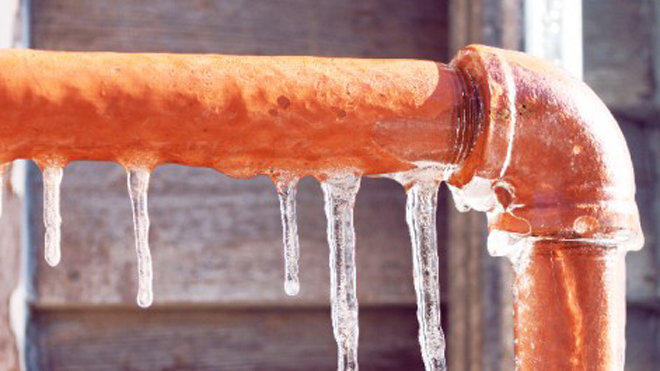Tips to Defend Plumbing System from Freezing: Critical Advice
Tips to Defend Plumbing System from Freezing: Critical Advice
Blog Article
We've come across this post relating to 6 Ways to Prevent Frozen Pipes directly below on the internet and concluded it made sense to share it with you on this page.

Cold weather can damage your pipes, especially by freezing pipes. Right here's exactly how to stop it from happening and what to do if it does.
Introduction
As temperature levels drop, the risk of icy pipes boosts, potentially causing expensive fixings and water damages. Recognizing just how to stop frozen pipes is essential for house owners in cool environments.
Avoidance Tips
Shielding at risk pipelines
Wrap pipes in insulation sleeves or use warmth tape to shield them from freezing temperature levels. Focus on pipes in unheated or outside areas of the home.
Heating strategies
Keep interior rooms appropriately heated up, especially locations with plumbing. Open up cabinet doors to permit warm air to flow around pipes under sinks.
Just how to determine icy pipes
Seek decreased water circulation from taps, uncommon smells or sounds from pipelines, and noticeable frost on exposed pipes.
Long-Term Solutions
Architectural changes
Take into consideration rerouting pipelines away from exterior walls or unheated locations. Include additional insulation to attics, cellars, and crawl spaces.
Updating insulation
Purchase premium insulation for pipes, attics, and walls. Correct insulation assists maintain consistent temperature levels and decreases the risk of frozen pipes.
Protecting Outside Pipes
Garden pipes and outdoor taps
Disconnect and drain pipes yard hose pipes prior to wintertime. Install frost-proof faucets or cover exterior faucets with protected caps.
Understanding Frozen Pipelines
What causes pipes to freeze?
Pipelines ice up when exposed to temperature levels listed below 32 ° F (0 ° C) for expanded durations. As water inside the pipelines ices up, it increases, taxing the pipeline wall surfaces and potentially triggering them to burst.
Risks and damages
Icy pipelines can bring about water disturbances, property damages, and pricey repair services. Burst pipes can flooding homes and trigger extensive architectural damages.
Signs of Frozen Piping
Determining frozen pipelines early can avoid them from breaking.
What to Do If Your Pipelines Freeze
Immediate actions to take
If you presume frozen pipelines, keep taps open to eliminate pressure as the ice thaws. Use a hairdryer or towels taken in warm water to thaw pipes gradually.
Conclusion
Stopping icy pipes needs aggressive steps and fast responses. By understanding the reasons, indications, and preventive measures, homeowners can protect their pipes throughout winter.
6 Proven Ways to Prevent Frozen Pipes and Protect Your Home
Disconnect and Drain Garden Hoses
Before winter arrives, start by disconnecting your garden hoses and draining any remaining water. Close the shut-off valves that supply outdoor hose bibs and leave the outdoor faucet open to allow any residual water to drain. For extra protection, consider using faucet covers throughout the colder months. It’s also important to drain water from any sprinkler supply lines following the manufacturer’s directions.
Insulate Exposed Pipes
Insulating your pipes is an effective way to prevent freezing. Pipe insulation is readily available at home improvement stores and is relatively inexpensive. Pay close attention to pipes in unheated areas such as the attic, basement, crawl spaces, or garage. Apply foam insulation generously to create a buffer against the cold. You can also wrap your pipes in heat tape or thermostat-controlled heat cables for added warmth.
Seal Air Leaks
Inspect your home for any cracks or openings that could let in cold air. Seal any holes around the piping in interior or exterior walls, as well as the sill plates where your home rests on its foundation. Additionally, make sure to keep your garage door closed unless you’re entering or exiting. Leaving it open creates a significant air leak that can lead to frozen pipes.
Allow Warm Air Circulation
During cold snaps, it’s essential to allow warm air to circulate evenly throughout your home. Leave interior doors ajar to promote better airflow. Open kitchen and bathroom cabinets to help distribute heat consistently around the rooms. If you have small children or pets, be sure to remove any household chemicals or potentially harmful cleaners from open cabinets for safety.
Let Faucets Drip
A small trickle of water can make a big difference in preventing ice formation inside your pipes. When temperatures drop significantly, start a drip of water from all faucets served by exposed pipes. This continuous flow helps prevent the water from freezing. Additionally, running a few faucets slightly can relieve pressure inside the pipes, reducing the chances of a rupture if the water inside does freeze.
https://choateshvac.com/6-proven-ways-to-prevent-frozen-pipes-and-protect-your-home/

I discovered that piece of writing on Preventing and dealing with frozen pipes while looking around the web. Make sure you set aside a second to distribute this page if you enjoyed reading it. Thanks for going through it.
Need Help? Hire Us Now! Report this page